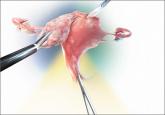Like Dr. Garcia, I too, have seen many cesarean-scar defects; most were diagnosed prior to surgery by my in-house technicians during vaginal ultrasonography.
I would like to add that, in addition to these defects, some patients who have undergone cesarean delivery also may form a mucocele in the scar that causes pain, bladder urgency, and dyspareunia. These defects also can be seen by ultrasonography, but in some cases may erroneously be labeled “nabothian cysts” by a radiologist. Most mucoceles probably are caused by incorporation of endocervical glands within a very low transverse uterine incision. Discovery and removal of these mucoceles during hysterectomy result in a very satisfied patient whose pain and urinary symptoms are resolved.
David G. Bryan, MD
Monroe, Louisiana
We commend Dr. Barbieri for his April 2014 editorial, “Following cesarean delivery, what is the optimal oxytocin infusion duration to prevent postpartum bleeding?” because he addresses a critical gap in the evidence regarding oxytocin administration postpartum. Standardized protocols for such administration are lacking at many facilities.
Our multidisciplinary team developed a standardized postpartum oxytocin administration protocol to prevent postpartum hemorrhage (PPH) based on limited evidence from trials in which 10 units to 80 or more units of oxytocin were given (from <1 to 12 hours) postpartum.1–5 Our protocol is a “middle of the road’’ approach in which a total of oxytocin 60 U is administered intravenously postdelivery, including a bolus of oxytocin 15 U in 250 mL of lactated Ringers solution (LR) at delivery followed by an additional oxytocin 15 U in 250 mL LR over the next hour, then oxytocin 30 U in 500 mL LR at a rate of 125 mL/hr for the following 4 hours. Thus, the total time for oxytocin administration postdelivery is 5 hours, within Dr. Barbieri’s recommendation of 4 to 8 hours
We have since performed a retrospective quality improvement assessment comparing PPH rates at 6-months preprotocol (n = 1267) with rates at 6-months postprotocol (n = 1440) implementation. PPH was defined as PPH treatment by pharmaceutical, mechanical, or surgical methods. Inclusion criteria included all deliveries at greater than 23 weeks’ gestation from April 2012 to March 2013. Patient characteristics for both cohorts were similar for race, age, parity, gestational age, delivery type, and neonatal weight.
The PPH rate decreased 37% after protocol implementation (adjusted relative risk [ARR], 0.63; 95% confidence interval [CI], 0.46–0.91). Administration of misoprostol, carboprost, methylergonovine maleate, and blood products decreased postprotocol implementation by 36%, 38%, 32%, and 22%, respectively. The PPH rate for women with a vaginal delivery decreased significantly after protocol implementation (5.9% preprotocol vs 3.8% postprotocol; P = .03). The PPH rate for women undergoing cesarean delivery increased, but not significantly, after protocol implementation (6.9% preprotocol vs 8.6% postprotocol; P = .34).
We did not control for some PPH risk factors, including abnormal insertion of placenta, preeclampsia, and multiple gestation. Despite this limitation, our PPH rate for women undergoing cesarean delivery is lower than other published rates.6,7 These findings are the preliminary step in a larger, more comprehensive 4-year study.
Our team is encouraged by these results and believes our protocol warrants further study. Thank you for your attention to this topic. We hope our experience can offer support for future practice change and research.
Enas Ramih, MD, MPH; Jennifer Doyle, MSN, WHNP; Tiffany Kenny, MSN;
Michele McCarroll, PhD; Vivian von Gruenigen, MD
Summa Health System Akron City Hospital
Women’s Health Services
Akron, Ohio
References
1. Tita AT, Szychowski JM, Rouse DJ, et al. Higher-dose oxytocin and hemorrhage after vaginal delivery: a randomized controlled trial. Obstet Gynecol. 2012;119(2 pt 1):293–300.
2. Munn MB, Owen J, Vincent R, Wakefield M, Chestnut DH, Hauth JC. Comparison of two oxytocin regimens to prevent uterine atony at cesarean delivery: a randomized controlled trial. Obstet Gynecol. 2001;98(3):386–390.
3. Murphy DJ, MacGregor H, Munishankar B, McLeod G. A randomised controlled trial of oxytocin 5IU and placebo infusion versus oxytocin 5IU and 30IU infusion for the control of blood loss at elective caesarean section: pilot study. ISRCTN 40302163. Eur J Obstet Gynecol Reprod Biol. 2009;142(1):30–33.
4. King KJ, Douglas MJ, Waldmar U, Wong A, King RAR. Five-unit bolus oxytocin at cesarean delivery in women at risk of atony: a randomized, double-blind, controlled trial. Anesth Analg. 2010;111(6):1460–1466.
5. Gungorduk K, Asicioglu O, Celikkol O, Olgac Y, Ark C. Use of additional oxytocin to reduce blood loss at elective caesarean section: a randomized control trial. Aust N Z J Obstet Gynaecol. 2010;50(1):36–39.



